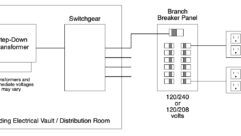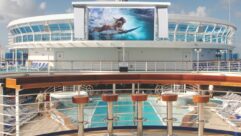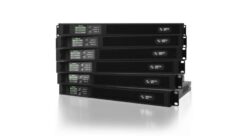
Technology Showcase:
High-power Amps
Oct 1, 2006 12:00 PM,
By Bruce Borgerson
Thundering kiloamps attack at 1kW-plus per channel.
This article developed like the plot of a “B” horror movie; Invasion of the Body Snatchers — I prefer the 1956 original version — comes to mind. At first, only a smattering of them were visible, sitting grandly at the top of a few premium-priced amplifier lines. When I first discussed this article with SVC‘s editorial team in late 2005, we surmised that no more than a couple dozen amplifiers were on the market that could deliver an honest 1,000W or more per channel at 4Ω — in other words, a kiloamp.

Peavey CS 4080HZ
No problem, the topic is under control — or so we thought. With each passing month and at each industry tradeshow, more of these creatures emerged, often, not just as one in a model series, but two or three. In ads and press releases, they multiplied like, well, zombies. Today, kiloamps are everywhere.
CLASS H
It wasn’t long ago that the thought of 1,000W per channel brought a twinge of pain. Even half that amount of power demanded hefty iron transformers and voluminous capacitors, all housed in a tank-like cabinet often 4RU high. Wrestling one of these beasts into a rack was a rite of manhood in the contracting business.
No more. Most kiloamps now tip the scales between 20lbs. to 40lbs., and are squeezed into modest 2RU cabinets. Only a half dozen weigh more than 50lbs., and with rare exceptions, these are the ones also occupying 3RU space. The two factors responsible for this remarkable slimming down are, of course, the near-universal application of switch-mode power supplies and the refinement of newer, highly efficient output topologies.
Regarding the latter, the clear winner of the class struggle in the high-power category is Class H. That’s primarily because the other major contender for high-efficiency honors, the quasi-digital Class D, has trouble staying linear at very high power levels: The semiconductor devices can’t maintain the mandatory “all on, all off” switching at the required high frequencies. That leaves the field open to the rail-switching approach of Class H, which now accounts for nearly two-thirds of the kiloamp models surveyed. Most others employ proprietary designs, usually incorporating some type of rail switching or a hybrid Class D/Class AB approach. Only a dwindling few weighty entrants stick to a traditional Class AB topology.
WHAT’S A WATT?
Good question. Any discussion of power amplifier ratings reveals an embarrassing void in the pro audio industry: There is no single agreed standard.
Is that 1,000W EIA? With 1 percent or 0.1 percent THD? Or are you confident enough to use FTC? Perhaps EIAJ or IHF? Or is this a proprietary standard using a tone burst designed to mimic the dynamics of contemporary music? (Lab.gruppen has adopted the latter approach, for example.)
All are valid — more or less. None are directly comparable. Even if you toss in distortion levels and compare the relative crest factors (peak-to-RMS value), you still don’t know how long the power levels can be sustained before the amplifier self-limits or shuts down. It’s not exactly smoke and mirrors, but we are dealing with some wide, fuzzy lines.
If there is anything close to a default standard, it would be the EIA rating. That’s mainly because the EIA standard is relatively forgiving, at least when compared to the stringent FTC standard. (The FTC rating for the same amplifier is usually 10 percent to 20 percent lower.) Even when publishing other ratings, many manufacturers will give the EIA rating as well.
Therefore, for the general purposes of this broad survey, the following caveats apply:
- Power ratings are assumed to be EIA, unless otherwise noted.
- Power ratings from different makers may not be directly comparable.
- Power ratings of amplifiers in different lines from the same manufacturer may not be directly comparable. (Some use different ratings for different series, for instance.)
That said, all the amplifiers listed here are pretty darn powerful. All will make a loudspeaker — more likely an array of loudspeakers or a massive subwoofer — get very loud. That’s when the other relevant questions come into play: How will it integrate into my planned system? Does it have the features I need: connectors, filters, DSP options, or computer control and monitoring? What protection circuits are built in? And lastly, but largely subjective, how does it sound?
KEY PLAYERS

Dynacord H2500 and H5000
Because of the above-noted proliferation of models, all the various factors cannot be covered in detail for all qualifying amplifiers. Extra attention will be granted to lines and models of particular interest to the installation market, based on an admittedly loose set of criteria: connector options, appropriate or advanced features, and breadth of market support in North America. Recent product introductions also will receive particular notice.
Note that all power ratings are per channel at 4Ω nominal, with any specifics given as available. Output is Class H, unless noted otherwise. Regarding terminology: “combo” refers to XLR+1/4, Phoenix is the same as Euroblock, and NL4 is shorthand for Neutrik’s Speakon.
Ashly Audio kicks off our kiloamp attack with three qualifying models in its impressive PE (Protea Enabled) series of high-power amplifiers. The flagship of the line is the 3800, which delivers 1,900W (20Hz to 20kHz 1 percent THD), weighs in at a sprightly 24lbs., and lists for $2,970. All PE series amplifiers are designed to integrate with Ashly’s Protea DSP systems. Setup, monitoring, and control is accomplished over a standard Ethernet connection. Audio connectors on the rear of the 2RU cabinet include combo and Phoenix inputs with outputs on NL4. Standard onboard analog processing includes subsonic filter, clip limiter, and input sensitivity selection. Optional DSP cards add a range of EQ, dynamics, and delay functions.
Stepping down in power are the 3000 (1,500W; $2,520) and the 2400 (1,200W; $2,070), both sharing the same size, weight, and feature set as the 3800. All three are capable of directly driving 70V systems at power levels of 1,200W, 1,500W, and 1,700W, respectively.
Ashly also distributes the German-made Camco Vortex series in the United States. Targeted primarily at touring applications, the Vortex line has three models of the kilowatt line: the Vortex 4 (1,570W), the Vortex 6 (2,300W), and the Vortex 200V (3,100W). A remote control data port is provided, peripheral modules facilitate application-specific configurations, and list prices start at $3,545 for the Vortex 4.
Architectural Acoustics, the installation-oriented division of the multi-faceted Peavey group, leads off the company listings with its ICA 2400. This is a no-nonsense contractor amplifier with a bare-bones faceplate and installation connectors: Phoenix inputs and barrier strip outputs. The rear panel also sports input attenuators and connectors for sequential power on/off. Power rating is a creditable 1,200W (20Hz to 20kHz, 0.1 percent THD). Other indications of an installation focus are the 45lbs., 3RU cabinet and availability of a 70V version.
Peavey was a pioneer of PWM designs with its landmark DCA amplifiers of the mid-1980s. It’s appropriate, then, that the company’s Crest division now claims the sole Class D entry in the kiloamp category. Tagged the CD (current draw) series, these amps tout the inherent high efficiency of the design. The sole qualifier here, the top-end CD 3000, produces 1,500W per channel, yet keeps current draw at less than 15A at one-third full-rated power. The 2RU package, a middleweight at 46lbs., retains traditional touring-oriented features such as big attenuators, large LED indicators, and handles. Inputs are combo jacks, while outputs offer a choice of NL4 or binding posts. List price is attractive at $2,000. Crest also offers a pair of touring-oriented Class H kiloamps, the Pro 7200 (1,000W; $2,025) and the Pro 9200 (2,200W; $3,392).
Crown has been a top player among high-power amp makers for decades, and the company aims to cement its position by offering a wide range of feature sets and price points. The flagship of the Crown Empire is the undeniably awesome — albeit pricey — I-Tech 8000. More than an amplifier, this is really a digitally networked processor/amplifier system.
Certainly the basics are all there: 4,000W per channel (20Hz to 20kHz, 0.35 percent THD) in an appropriately high-tech 2RU cabinet weighing a mere 28lbs. Output stage is Crown’s patented Class I adaptation of PWM technology. Of course, for a list price of $7,685, you expect some add-ons, such as power factor correction, standard AES/EBU digital inputs (CobraNet optional) with 24-bit/96kHz converters, and a full suite of integrated DSP options with recallable presets. I-Tech 8000 has it all and more, as do the step-down models: the I-T6000 (3,000W; $6,117) and I-T4000 (2,000W; $5,000).
The brute power end of Crown’s installation-oriented CTs series also ascends to the kiloamp range. Also using Class I outputs, and with Harman’s HiQ-net available as an option, the CTs 3000 ($3,354) produces 1,500W, while the CTs 2000 claims a relatively modest 1,000W. Straightforward installation connections are Phoenix input and barrier strip output. Both can drive constant voltage systems directly.
The Telex group markets a bevy of kiloamps under both the Dynacord and Electro-Voice (EV) monikers. On the Dynacord side, the latest models are the PowerH series H2500 ($3,150) and H5000 ($4,250). The former claims 1,250W, while the latter boosts output to 2,500W. The compact 2RU package incorporates three-tier grounded bridged Class H outputs, “floating” switch-mode power supply, and IRIS-Net compatibility for networked applications. Embedded in the signal path, according to Dynacord, is a microprocessor-controlled comparator circuit that extends dynamic range and limits distortion at high output levels. A large LCD display accesses internal information via associated menu buttons. For flexibility, the Power H units provide parallel XLR and Phoenix inputs (plus XLR line-outs), and both NL4 and binding post power outputs.
On the EV side, the Precision Compact Series places two models in the kiloamp range, the CP3000S (1,100W) and the brand-new flagship of the line, CP4000S (1,500W). Weighing in at a remarkably light 18lbs. and 19lbs., respectively, the duo features XLR in with parallel XLR line out and NL4 output connectors, including a dedicated NL4 for bridge-mode output. List price for the CP4000S is $2,390.
Sweden’s Lab.gruppen recently entered the installation market with the C Series, distinguished here as the only products offering better than 1,000W per channel in 4-channel units. The two qualifying models — a third misses out only because bridging is disallowed — are the C68:4 (1,700W) and C48:4 (1,200W). Of course, the channel pairs are bridgeable, so you can configure a C68:4 for 3,400W + 3,400W, or 3,400W + 1,700W + 1,700W — ideal for mixed systems of anything from subwoofers to 70V lines, which can be driven directly.

Lab.Gruppen C series
The output is a patented Class TD design, which claims Class D efficiencies with a Class AB final output. Input and output connectors are Phoenix and barrier strip respectively, and an array of DIP switches sets input gain and Lab.gruppen’s proprietary VPL load-matching feature. A standard module connects with the company’s proprietary NomadLink monitoring and control network. The C68:4 lists at $4,895 and the C48:4 at $3,845, but, remember, divide by four to compute per-channel cost.
Lab.gruppen options multiply with the established, touring-oriented fP Series and the brand-new, beefed-up FP+ Series. An impressive six additional models from these series (two of them 4-channel) ascend to kiloamp status, all with Class TD output stages. Notable are the FP+ 13000 (2 × 6,500W) listing for $6,995 and the 4-channel FP10000Q (4 × 2,500W) with a $7,295 tag.
THE NEW AND THE FAMILIAR
MC2 and Powersoft are two European manufacturers — from the United Kingdom and Italy, respectively — primarily focused on touring applications. As yet, they have minimal presence in the North American installation market, but that could change as both makers have plenty of power readily available in small, lightweight packages.
MC2 offers the E25 ($3,495) and the E45 ($4,695) in blue industrial-strength cabinets. Power ratings are 1,250W and 2,250W, respectively, with the scales tipping below 25lbs. each.
If small is beautiful, then Powersoft’s DIGAM series of 1RU kiloamps are looking most attractive. Though using a relatively forgiving 1kHz/1 percent THD rating, the total number of entries is nonetheless impressive: seven 1RU claiming more than 1,000W per channel. Its flagship unit is the new DIGAM K10 ($7,995), with a published rating of 4,000W per channel. Powersoft is a relative neophyte in the North American market (as evidenced by its English-language promotional materials), but this exceptional level of power density is worthy of consideration when space is at a premium.
QSC Audio, on the other hand, has long been a familiar name among North American installers. The company’s founding focus on lightweight power is illustrated by a dozen QSC amplifiers in six product lines that make the grade. All use a proprietary application of Class H in both two- and three-tier configurations.
Those of greatest interest here would be the contractor-friendly CX 1102 and its 70V cousin, the CX 1202V. Both produce 1,100W (FTC, 0.1 percent THD) and feature XLR and Phoenix inputs, barrier strip outputs, dataport for QSControl, and selectable high-pass filters. Weight is a comfortable 2lbs.
QSC also offers the ISA 1350 (1,300W FTC; $1,820); three models in the touring-oriented PowerLight series (1,150W, 1,400W, and 2,050W FTC) at list prices starting at $3,240; two in the PowerLight 2 series (1,050W EIA and 1,300W FTC), starting at $1,950; two in the lightweight (21lbs.) PLX2 series (1,000W and 1,250W), starting at $1,299; and the big guys in the RMX series — the RMX 4050HD (1,300W FTC) and 5050 (1,600W FTC).
Though the RMX 4050HD and 5050 are heavyweights (the 5050 weighs in at 75lbs.) in 3RU cabinets, the respective list prices of $1,650 and $2,550 represent good value for a full-featured amplifier with such ample power reserves.
YAMAHA’S TN DEBUT

Yamaha Tn5
Whereas QSC has its roots deep in professional amplifiers, Yamaha branched out into the product area from, well, just about everywhere. A few years back, Yamaha devoted some of its considerable engineering resources to development of a proprietary output stage, which it calls EEEngine. It’s similar in respects to Lab.gruppen’s Class TD in that both use elements of Class D with an AB final output, though distinct enough to avoid a patent squabble.
Yamaha’s first two entries in the kiloamp range were the PC9501N (1,600W; $1,699) and PC6501N (1,100W; $1,549), both weighing less than 30lbs. and compatible with Yamaha’s CobraNet-capable NetworkAmp manager system.
In late 2006, the company expanded its high-power presence with the Tn Series, and all three new entries are solidly in the kiloamp range. The Tn5 ($3,799) delivers 2,300W, the Tn4 ($2,999) notches down to 2,050W, and the Tn3 ($2,399) claims a respectable 1,400W. The power supply has an upgraded regulation circuit, and the EEEngine output for this series has been refined with the addition of an FET drive circuit, which acts as a high-efficiency current buffer. All Tn amplifiers are rated at 2Ω, which makes them particularly attractive for the touring market, and all tip the scales right around the 30lbs. mark.
WAIT, THERE’S MORE
Is that it? Has the assault of the kiloamps ceased for the time being? Not hardly. The above listings were loosely restricted to companies with established presence in the contracting or tour sound industries, or both. Several other companies with support and distribution focused on the MI (musical instrument) and lower-end club markets also have joined the kiloamp fray. With all entries listing for less than $2,000, and often heavily discounted, these kiloamps may be worthy of consideration when serious value engineering comes into play.
Crate Audio’s entry, for instance, is heavy in the rack, but light on the pocketbook. Weighing in at 79lbs., the SPA2000 claims 1,150W per channel, sports a basic feature set, and lists for $749. (This computes to $0.68 per watt or $9.48 per pound.)
Mackie’s twin offerings, the Class H M2000 and M3000 produce 1,000W and 1,300W, respectively. Weights of 48lbs. and 53lbs. make them light heavyweights, but MSRPs less than $1,099 and $1,299 make them highly competitive for many no-nonsense applications.
Peavey started in the MI market and honors its roots with products like the CS 4080HZ. It delivers 2,040W from a 2RU, 53lbs. package, includes proprietary DDT clip protection, and discounts down from a list of $1,599.
Samson is known for making music reliably on a tight budget, and the SX3200 easily fits the bill here. The Class H kiloamp claims 1,100W, sports combo inputs, dual outputs (NL4 and binding post), and does it all for a list price of $799.
Big, black, and basic would describe the TA4000 from TCS. A Class AB design, it pours out 1,200W from a 3RU cabinet that weighs a remarkably reasonable (for Class AB) 50lbs. Nothing fancy here, but basic brute power for $1,195 is noteworthy.
Finally, attacking from the north is the beefy AP series from Yorkville Sound of Canada. The 3RU AP 6040 checks in with 2,000W and tips the scales at a hefty 67lbs., while the AP 6020 kicks out 1,200W from a slimmer 2RU, 44lbs. package. List for the latter is $1,999.
That’s a broad overview. Still, this survey describes the frontal assault as of press time. By the time you read this, at least two major industry tradeshows will have come and gone, and it’s likely that many more kiloamps will have been unleashed. At least now you know an invasion is fully underway, and you can strategize on how best to use it to your advantage.
For More Information
Ashly
www.ashly.com
Architectural Acoustics
aa.peavey.com
Camco
www.camcoaudio.com
Crate
www.crateaudio.com
Crest
www.crestaudio.com
Crown
www.crownaudio.com
Dynacord
www.dynacord.com
Electro-Voice
www.electrovoice.com
Lab.gruppen
www.labgruppen.com
Mackie
www.mackie.com
Peavey
www.peavey.com
Powersoft
www.powersoft.it
Samson
www.samsontech.com
Yamaha
www.yamaha.com
Yorkville
www.yorkville.com
Bruce Borgerson,currently proprietor of Wavelength Communications (Ashland, Ore.), is uncertain of any relationship between his 2001 hernia surgery and the “big iron” amplifiers he schlepped as a contracting apprentice a couple decades earlier.










